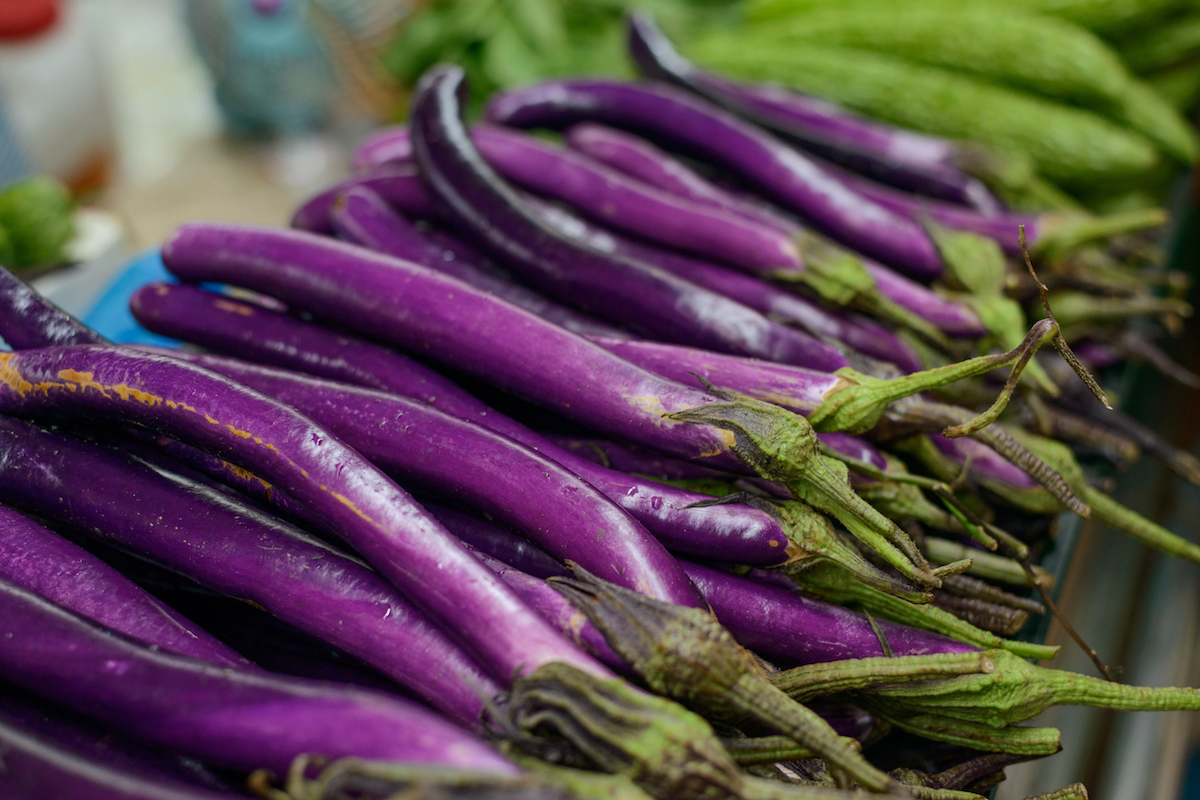This post may contain affiliate links. Please read my disclosure for details at the bottom of this page. As an Amazon Associate, I earn from qualifying purchases on this article about eggplants in Korean cooking. We hope you enjoy learning about the Korean eggplant (gaji).
In our household, we eat a lot of fruits and vegetables prepared using Korean seasoning, sauteing, and stir-frying methods. One of the most popular fruits used to make side dishes in South Korea is the ‘gaji,’ otherwise known as Korean Eggplant.
Here, we will learn about the Korean eggplant as well as list some dishes that use it as the main ingredient!
What Are Eggplants?
The Eggplant, otherwise known as aubergine or brinjal, is a variety of plant species in the nightshade family Solanaceae. As a member of the genus Solanum, eggplants are related to potatoes, chili pepper, and tomato. Around the globe, there are 18 different varieties of eggplant.
While there is no definitive known place of origin for the eggplant, some historians believe the species are native to India, Africa, and South Asia. The first known record of the plant can be found in Qimin Yaoshu, an agricultural treatise from ancient China dating back to 544 CE.
For a long period, because eggplants are in the nightshade family, people believed that eggplants were poisonous. While the fruits are not, do not eat the flower or leaves in large quantities due to the presence of solanine, a toxic poison.
Eggplant Fact: Eggplants are fruits, not vegetables!
What Is a Korean Eggplant (Gaji)?
The Korean variety of eggplant is long and thin with a medium, thin skin. These dark purple eggplants have a softer, less spongy texture than the typical eggplant found in most western grocery stores.
Further, compared to the western globe eggplant, otherwise known as the American eggplant, the Korean eggplant has a milder, sweeter flavor.
Gaji In Korean Cooking:
In South Korea, people refer to eggplants as ‘gaji’ (가지).
People eat Korean eggplants raw, steamed, pan-fried, stir-fried, and in soups and stews as well as jeon. Below, we list a few ways people use this fruit as an ingredient in cooking:
Korean Eggplant Recipes:
- Gaji Namul (가지나물): This Korean seasoned eggplant side is a popular summer vegetable-based dish. It takes very little effort to make and you can eat it throughout the week.
- Gaji Bokkeum (가지볶음): In English, we refer to this dish as an ‘eggplant stir fry.’
Korean Eggplant Frequently Asked Questions:
Now that we learned about eggplants in Korean cuisine, we want to answer some questions you may have about this ingredient! If we do not answer your question, feel free to leave a comment in the section below or email us at [email protected].
Where Can I Buy a Korean Eggplant?
Typically, you need to buy these long and thin eggplants at an Asian grocery store. That being said, you may sometimes find them at your local farmer’s market or grocery store.
If you cannot find these Korean eggplants, you can substitute them with any other eggplant variety you are able to find.
How Do I Properly Store This Ingredient?
Instead of storing eggplants in the refrigerator, I recommend storing them at room temperature, where they last longer.
At room temperature, store the eggplant in a cool, dark place away from direct sunlight. Use it as soon as possible after buying or harvesting.
Once you cut the eggplant, store the pieces in the refrigerator!
We Hope You Enjoyed Learning About the Korean Eggplant!
In the end, we hope you enjoyed learning about the Korean eggplant! If so, let us know in the comment section!
If you would like to read more about cooking, you can find recipes as well as further Korean ingredient articles on our blog. We listed some of our favorite Carving A Journey Korean recipes below! For reference, many recipes are influenced by our blended Korean and Southern heritage.
Korean Ingredient Articles:
- Jujubes in Korean Cooking (Daechu)
- Chrysanthemum Greens in Korean Cooking (Ssukgat)
- Dandelion Greens in Korean Cooking (Mindeulle)
- Korean Fermented Salted Shrimp (Saeujot)
- What Is a Korean Melon? (Chamoe)
- Black Sesame Seeds in Korean Cooking (Heukimja)
Further Carving A Journey Recipes:
- Mango Bingsu (Korean Shaved Ice)
- Peach Sweet Tea and Bourbon Cocktail
- Strawberry Matcha Latte
- Korean Banana Milk
- Korean Strawberry Milk
- Soju Cocktail: Soju Caipirinha
- Iced Burnt Brown Sugar Latte
- Classic Southern Lemonade
If you have any questions or comments, you can also email us at [email protected].
And, finally, we would love to hear from you through our social media as well! You can follow us at @carvingajourney on Instagram, Facebook, and Pinterest. I also started a vlog Youtube channel! Or, if you would like more articles like these, you can subscribe to our blog by joining our mailing list. Let us know if you try using gaji when cooking! Thank you so much for stopping by!
Carving A Journey is a participant in the Amazon Services LLC Associates Program, an affiliate advertising program designed to provide a means for sites to earn advertising fees by advertising and linking to Amazon.com. Although we may earn commissions for our endorsement, recommendation, testimonial, and/or link to any products or services from this website, these opinions are my own and I fully support these products.

